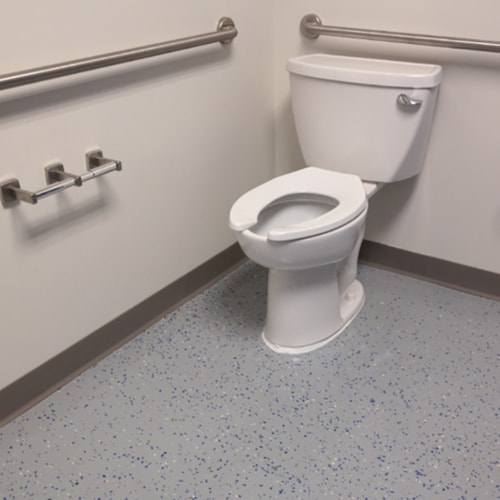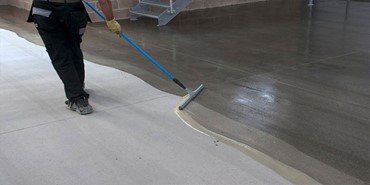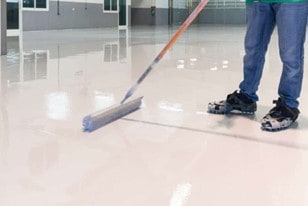Toilets are integral and highly used spaces in every facility. Without any doubt, everyone knows that the bathroom floor should be waterproofed. The facility image is an important component of a building for property owners’ friends and visitors’ to have their first impression of cleanliness. Durable flooring coating must be able to resist daily usage, wear and tear as well as harsh chemical cleaners. Epoxy flooring is one of the most preferred floor coatings which meets these requirements. There are other waterproofing coatings available in Singapore, such as Nano coating and other waterproofing membranes as well.
Epoxy flooring is a flooring material that is increasing its popularity in Singapore. Epoxy coating is commonly used in the waterproofing industry. It is a mixture of polymer resins and hardeners that are applied to concrete flooring. This liquid-to-solid process gives epoxy flooring the ability to be strong, and stain-resistant for toilets, and washrooms well.
Epoxy floor coatings are widely used in industrial and commercial flooring. The epoxy coating was traditionally used for factories, garages, and basements but there are new types of epoxy available for kitchens or bathrooms these days.
Every type of flooring comes with its set of pros and cons. Read on to know more about its individuals.
Advantages of Epoxy flooring
Epoxy flooring is highly durable, sustainable, and decorative for any surface. Epoxy is appealing with its glossy finishing which makes a good aesthetics to many homes and commercial environments. Epoxy gives a high-performance, smooth, shiny surface that gives a clean and elegant feel to the flooring. The durable and visually stunning finish makes it suitable for most residential, industrial, and commercial flooring.
They are resistant to high levels of wear and tear, peeling, and corrosion, and resist scratch and moisture with cured epoxy due to the composition of the ingredients.
Chemical resistant, such as oil, gas, bleach, acids, and other chemicals or washing agent. Therefore, minimum maintenance is required. Epoxy floorings are easy to clean, wiping and brushing the floor with water and a mild detergent will be sufficient. A thorough rinse with water and mopping clean cloth will complete the task. It saves time and money on buying high-intensity cleaning detergents and tools to clean the toilet flooring.
Epoxy flooring is commonly found in laboratory and medical facilities. An epoxy floor is a popular option for toilets and bathrooms because it is cost-effective and easy to maintain for homeowners.
Disadvantages of Epoxy flooring
Epoxy is both a blessing and a curse, removing and updating the epoxy coating is a costly and labour-intensive process. The weak point is they are not UV resistant therefore it is not ideal for outdoor areas such as balconies, open walkways, and swimming pools. It will lead to discoloration in patches and could lead to different colour variations.
It produces strong toxic fumes during application. It has a strong smell of ammonia when the flooring is still wet. The gases are harmful and can cause those nearby to have side effects on their health, therefore evacuation of family members and staff is advisable. It will cause inflammation in the nose and eyes, mouth and lungs are some of the typical signs and symptoms as a result of inhaling the fumes. Asthmatic people can have breathing issues.
The epoxy application requires precision and attention to detail. A primer coat is applied to aid the adhesion of the epoxy coating. The application is applied with a trowel, skills are required to apply the coating to avoid any bubbles and uneven installation. The floor will require to dry for up to 24 hours, some may require several days to dry the surface and harden completely. Some applications required as long as 30 days to dry and heal fully. This can cause inconvenience for any homeowner who is unable to vacant the house during the installation.
The epoxy coating could crack and chip on high-impact and high-traffic areas such as the kitchen, the bath area, balconies, and swimming pools. The homeowner will have to prepare for regular replacement of coating. The chips and cracks will ensure additional costs incurred for patching on the damaged areas.
Epoxy floor coating is very slippery when wet. This implies that when wet or when there is oil on the surface, it produces a very smooth surface that becomes hazardous, especially for children, the elderly, and even pets. There are some preventive ways to apply to render less slippery epoxy flooring, these measures area an extra cost, such as adding shark grip to the final textural coating and adding floor resistance. These strategies are an extra expense and not so appealing for beautification purposes.
Time-consuming for the installation process. It takes a lot of effort to prepare the concrete flooring before installation. Epoxy coating required a dry and smooth concrete surface, therefore cracks and chips are necessary to patch and smooth, and clean as well as to remove all grease and dry before applying an epoxy floor coating. Most importantly, the flooring has to be dust-free before epoxy application. Every layer of the coating has to be completely dried before applying the next coat. This progress will usually much longer time. The humidity level generally ends up harming the surface during installing epoxy coating and eventually impact the floor’s durability. Any amount of humidity trapped within the flooring material will cause significant damage to the epoxy installation. As trapped moisture begins to evaporate when the flooring materials dry, it can cause buckling, warping, and even bulging on the surface. When this happens, re-installing the coating is required and can incur additional costs. In some situations, small particles can be found under the application of epoxy will become the cause of cracks in the future.
The chemical bond creates a stiff plastic material that will degrade over a period of time, especially at high traffic movement places. The removal procedure is complex and expensive in the future. It needs grinding to extract epoxy from the concrete floor and it is a costly undertaking. Professionals contractor will be required to carry out the removal process. In addition, during the installation or removal of the epoxy coating protective gear will be required to protect themselves from inhaling excessive fumes that are harmful to human health.
Despite all the above understanding toilet epoxy flooring, will help you broaden your knowledge on epoxy flooring and enable you to consider your chance with the flooring. Prevent homeowners end up regretting the decision to install flooring that is not suitable for their needs. Every type of flooring has its disadvantages and advantages; epoxy flooring is no exception. Although it is popularly used in Singapore.
SWC Construction has a better waterproofing solution for homeowners and commercial and industrial businesses. Contact us, for more information, we have a skilled and professional staff, that guarantees you the best solution and quality results that last.





